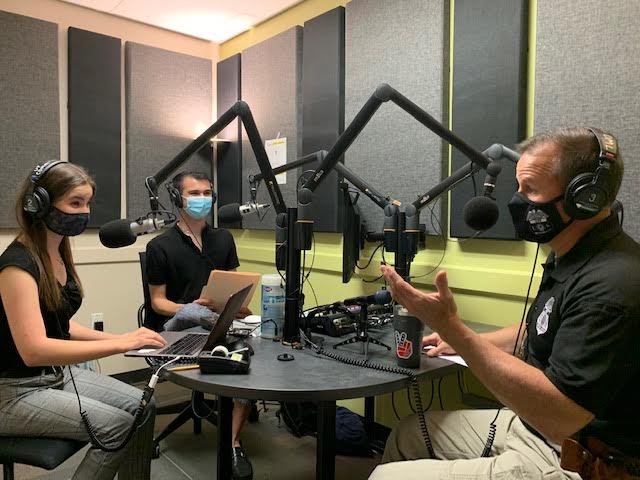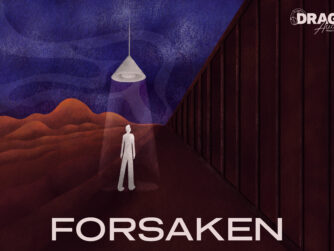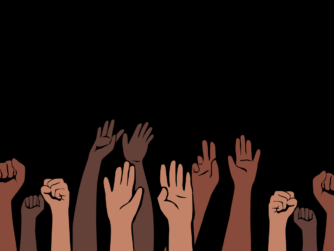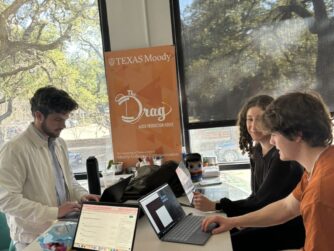Imagine the pressure attached to producing a new true crime podcast on the heels of the success of “The Orange Tree.” But when you have a partner who has your back, it’s not so bad.
Ashley Miznazi and Kenny Jones, co-hosts of The Drag’s next true crime podcast “Delivering Darkness,” first worked together at The Daily Texan, where they shot a video about a UT Austin diver who qualified for the Olympics (shameless plug here). Little did they know that months later, they’d be closer than they ever imagined, diving deep into a high-stakes podcast about the bombings that shook Austin in 2018.
Their chemistry is palpable, and it rubs off on anyone who comes into contact with them — including myself, after only talking to them for 40 minutes. The duo attributes much of the success and quality of the interviews they conducted to their compatibility and yin-and-yang energy.
When you’re interviewing the FBI, high-profile law enforcement figures and victims of the attacks plus their family members, it’s easy to feel the heat and get intimidated. After all, you want to do it right. Here are 6 tips that the “Delivering Darkness” duo shared for how to remain sensitive and composed during difficult interviews:
1. Be in it for the right reasons
One theme that kept popping up in my conversation with Miznazi and Jones was a journalist’s responsibility to be an enlightened skeptic. It’s evident from the pair’s reporting that they were guided by holding authority accountable and asking pressing questions to public officials who made mistakes. As Miznazi said, it’s an official’s job to be held to a higher standard; a family member didn’t choose for this to happen.
“Let sources know that it’s important to get their stories right,” Jones said. If something’s unclear, ask them to elaborate. Tell them to correct you if you’re wrong. Words hold power, and it’s important to get the nuances right.
“You want to include [sources] in the story as much as possible and make them feel like an actual part of the story that has actual influence because it’s their truth,” Jones said.
2. How you send your message is important
Whether contacting sources through Facebook Messenger, email or cold calls, Miznazi and Jones made it a point to be transparent and lay out their intentions off the bat. Being clear about the purpose of the project and what your role in it is, referencing where you found the source’s name and explaining why you want to talk to them shows you care. Miznazi said it can be jarring receiving a text from a stranger without knowing their motivations.
“Telling [sources] in that first message that you’re interested in hearing their story from their words and their voice is important,” Miznazi said.
Pro tip: When all else fails, don’t be afraid to crack open the good old-fashioned phone book and start calling numbers down the list. That’s how Miznazi eventually reached Collin Thomas, the Austin bomber’s roommate.
3. Give sources as many opportunities to say yes
It can be disappointing when you’re on pins and needles, waiting for a source to respond to your initial message, and you receive a no. Sometimes you might not hear back at all. But Jones and Miznazi said one way they landed many interviews after several attempts was by regularly following up and reminding sources that their doors were always open if any comments or questions arose.
At the same time, it was equally important for the team to not rub salt into the wounds of people who endured trauma. Be respectful of a source’s final wishes and don’t push too hard. Jones responded to the mother of a young victim of the bombings who didn’t want to be interviewed. He thanked her, showed his understanding, offered the option of a written or pre-recorded statement, and closed with a kind sentiment.
“My philosophy through the whole thing was I’m going to ask until I get a no, and when I get a no, I’m not going to ask them ever again,” Miznazi said.
4. Do your research
When juggling pending FOIA requests and contact information on upwards of 100 sources, Miznazi and Jones said it was imperative to keep their facts straight and stay organized using spreadsheets. Knowing the story and timeline inside out is a must before going into an interview, and it also allows you to fact-check in real time once the interview starts. The team joked they read every single article ever published about the Austin bombings until page 50 of Google search results, but part of me didn’t think they were entirely kidding.
The pair also emphasized the importance of being well-researched for pre-interviews, which aren’t actual interviews but opportunities for interested sources to learn more about the project before committing themselves.
“You’re going to be asked the hard questions — like, ‘Why are you telling a story about my dead son?’ — and you have to be ready to answer them,” Miznazi said.
5. Show empathy and be human
Miznazi and Jones’ dynamic helped them achieve the perfect balance of lightheartedness and seriousness during interviews that had the potential to be tense and anxiety-inducing. The two said they found it effective to ask sources what they ate for breakfast when doing mic checks in order to break the ice and begin with small talk before jumping into intense topics.
“When [sources] see us comfortable, it influences them, too,” Jones said. “In every single one of our interviews, for all the trauma we talked about, everyone’s been able to smile through it,” Miznazi said.
Pro tip: Miznazi and Jones love walking and talking with sources across the scenic bridge that connects the Dealey Center for New Media and the CMA before interviews because they discovered it helps loosen people up.
6. How to maintain intimacy and trust in virtual interviews
Doing interviews on Zoom never gets any easier, but Miznazi and Jones recommend always keeping your camera on, placing yourself in a well-lit position and resisting the urge to focus on your little box in the corner.
The team said they researched the methods psychologists use during telehealth appointments and learned that it’s helpful to remain eye-level with the camera to mimic eye contact.









